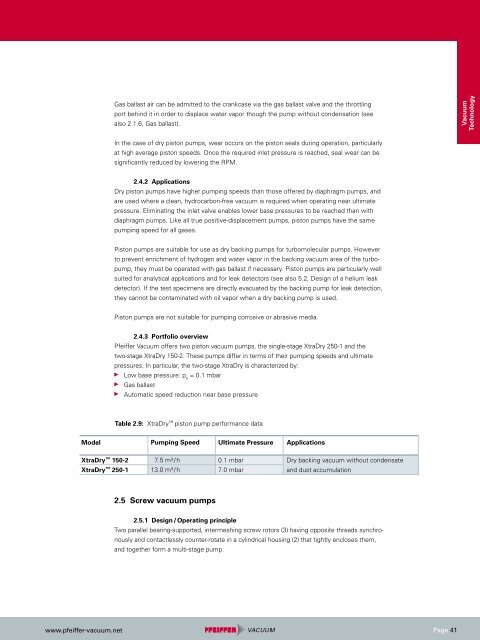Create successful ePaper yourself
Turn your PDF publications into a flip-book with our unique Google optimized e-Paper software.
Model<br />
XtraDry 150-2<br />
XtraDry 250-1<br />
www.pfeiffer-vacuum.net<br />
Gas ballast air can be admitted to the crankcase via the gas ballast valve and the throttling<br />
port behind it in order to displace water vapor though the pump without condensation (see<br />
also 2.1.6, Gas ballast).<br />
In the case of dry piston pumps, wear occurs on the piston seals during operation, particularly<br />
at high average piston speeds. Once the required inlet pressure is reached, seal wear can be<br />
significantly reduced by lowering the RPM.<br />
2.4.2 Applications<br />
Dry piston pumps have higher pumping speeds than those offered by diaphragm pumps, and<br />
are used where a clean, hydrocarbon-free vacuum is required when operating near ultimate<br />
pressure. Eliminating the inlet valve enables lower base pressures to be reached than with<br />
diaphragm pumps. Like all true positive-displacement pumps, piston pumps have the same<br />
pumping speed for all gases.<br />
Piston pumps are suitable for use as dry backing pumps for turbomolecular pumps. <strong>How</strong>ever<br />
to prevent enrichment of hydrogen and water vapor in the backing vacuum area of the turbopump,<br />
they must be operated with gas ballast if necessary. Piston pumps are particularly well<br />
suited for analytical applications and for leak detectors (see also 5.2, Design of a helium leak<br />
detector). If the test specimens are directly evacuated by the backing pump for leak detection,<br />
they cannot be contaminated with oil vapor when a dry backing pump is used.<br />
Piston pumps are not suitable for pumping corrosive or abrasive media.<br />
2.4.3 Portfolio overview<br />
Pfeiffer <strong>Vacuum</strong> offers two piston vacuum pumps, the single-stage XtraDry 250-1 and the<br />
two-stage XtraDry 150-2. These pumps differ in terms of their pumping speeds and ultimate<br />
pressures. In particular, the two-stage XtraDry is characterized by:<br />
Low base pressure: p b = 0.1 mbar<br />
Gas ballast<br />
Automatic speed reduction near base pressure<br />
Table 2.9: XtraDry piston pump performance data<br />
Pumping Speed<br />
7.5 m³ / h<br />
13.0 m³ / h<br />
2.5 Screw vacuum pumps<br />
2.5.1 Design / Operating principle<br />
Ultimate Pressure<br />
0.1 mbar<br />
7.0 mbar<br />
Applications<br />
Dry backing vacuum without condensate<br />
and dust accumulation<br />
Two parallel bearing-supported, intermeshing screw rotors (3) having opposite threads synchronously<br />
and contactlessly counter-rotate in a cylindrical housing (2) that tightly encloses them,<br />
and together form a multi-stage pump.<br />
Page 41<br />
<strong>Vacuum</strong><br />
<strong>Technology</strong>

















